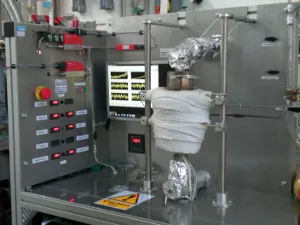Oxidation reactivity of bio fuel generated soot
Objectives
- Separation, identification and quantification of (micro)plastic particles in aquatic environments
- In-vivo studies on ingestion and possible accumulation of plastic particles in freshwater organisms
Methods of Approach
- Raman Microspectroscopy & Raman Imaging
- Munic Plastic Sediment Separator (MPSS)
Description
In recent years the pollution of marine environments with plastic waste has been well documented. High amounts of plastic particles accumulate in the sediments and in the pelagic zone and can be ingested by many organisms. However, only a few studies are known concerning the amount of discharged plastic particles to freshwater environments. There is a high requirement for scientific studies to examine the potential endangerment by plastic particles of these ecosystems.
A first important step in order to study the consequences of plastic debris in aquatic ecosystems is a reliable, verified and standardized approach to quantify the amount of plastic particles. We developed an accurate method based on density separation in a ZnCl2 solution (at density 1.6 – 1.7 kg/l) and constructed a Munich Plastic Sediment Separator which enables a reliable separation of different types and size classes of plastic particles from sediment samples. Subsequent identification of the particles with spatial resolution down to 1 µm is performed by Raman Microspectroscopy (RM). RM is the combination of Raman Spectroscopy, which is based on the inelastic scattering of light, with optical microscopy.
Moreover, we will investigate the impact of plastic particles on freshwater environments. We will use chosen species as examples for different functional groups and test for accumulation of plastic particles in the organisms and for influences to life-history, reproduction and mortality. Next to sophisticated histological techniques, RM will be used and further developed as an efficient method to show the ingestion and possible accumulation of plastic particles in organisms and organs in-vivo. This will help to foster studies quantifying the increasing contamination of aquatic environments with plastic particles, which is a crucial prerequisite for future risk assessment and management strategies.

Pubilcations
M. N. Ess, D. Ferry, E.D. Kirreva, R. Niessner, F.-X. Ouf & N. P. Ivleva, In Situ Raman Microspectroscopic Analysis of Soot Samples with Different Organic Carbon Content: Structural Changes During Heating, Carbon 2016, 105, 572-585
M. Ess, H. Bladt, W. Mühlbauer, S. Seher, C. Zöllner, S. Lorenz, D. Brüggemann, M. Nieken, N. P. Ivleva & R. Niessner, Reactivity and Structure of Soot Generated at Varying Biofuel Content and Engine Parameters, Combustion & Flame 2016, 163, 157-16
H. Bladt, N. P. Ivleva & R. Niessner, Internally Mixed Multicomponent Soot: Impact of Different Salts on Soot Structure and Thermo-Chemical Properties, Aerosol Science & Technology 2014, 70, 26-35